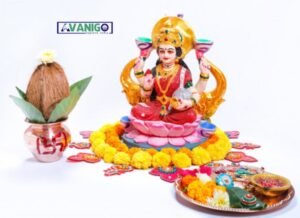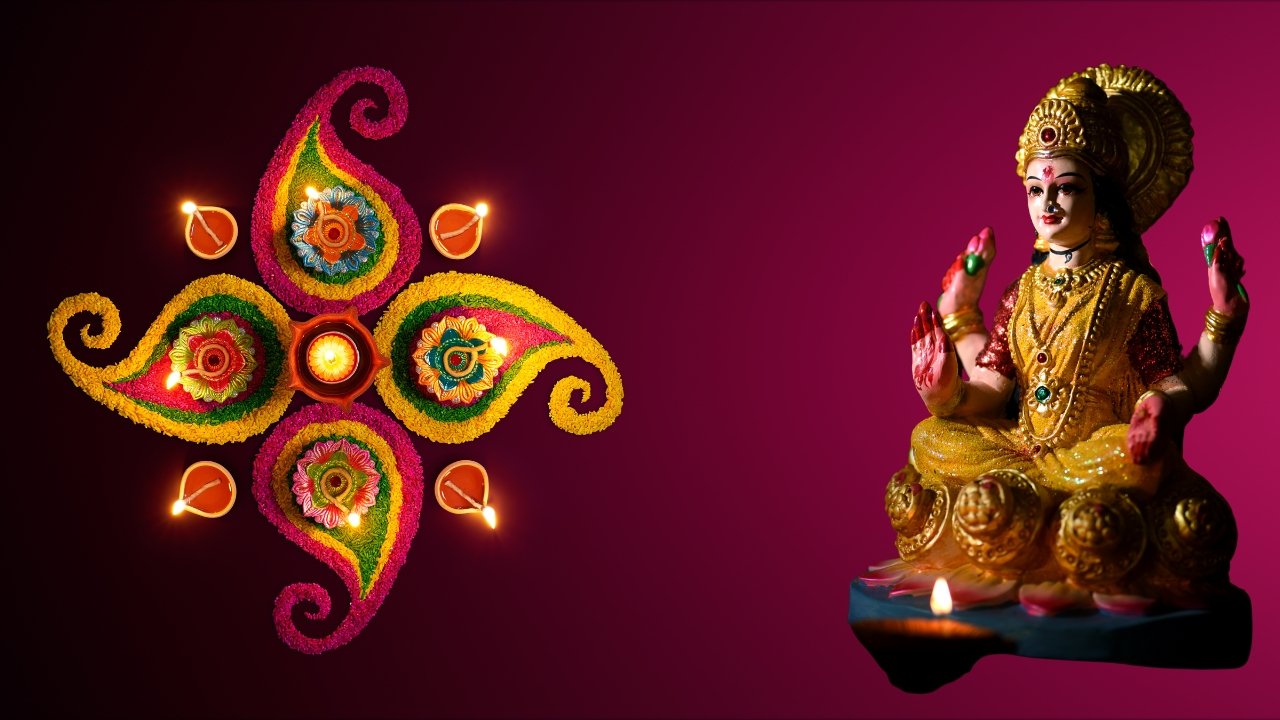Here, you will know all the facts about the Laxmi Pooja. Along with this, you will get information about the Lakshmi Pooja Muhurat and Lakshmi Pooja Vidhi.
Typically, Lakshmi Puja is performed on every Tuesday and Friday with dedication. During Diwali season, Lakshmi Pooja is performed on the new moon day, which falls on the third day of Diwali celebrations. Hindus consider Deepawali to be one of the most important and auspicious festivals. Lakshmi pooja is performed on Dhanteras too.
Deepavali is a festival of lights. Deepavali is known as the festival of lights because it is believed that Lord Rama came back to Ayodhya, accompanied by Sita and Laxman, after 14 years of exile. To celebrate this, the people of Ayodhya lightened the whole city with numerous Diyas.
Quick Navigation
Laxmi Puja on Diwali
The celebration of Deepawali is immensely associated with Laxmi Pooja. The business community of Hindus considers Diwali as the end day of the financial year. Due to this reason, they worship Goddess Lakshmi as she is a symbol of wealth.
In some states like West Bengal & Orissa, Goddess Mahakali is worshipped during Diwali. People start the celebration of Lakshmi Pooja by wearing new clothes. After that, they visit their friends and families with gifts.
On Diwali, people draw beautiful Rangolis in front of their houses and in puja rooms. People decorate their homes with colourful Diyas and lights in the evening. Lakshmi puja celebration is one of the interesting facts about Diwali.
After performing Lakshmi Pooja & Saraswati Pooja, a new accounts register is opened by a businessman. It is believed to be a sign of fortune. Laxmi Pooja is performed every year as a representation of luck, happiness, health, and wealth.
After the completion of Laxmi Pooja, people start exchanging gifts with their friends and family.
Lakshmi Puja Vidhi at home
Lakshmi Pooja Vidhi is quite simple compared to other worships. Ganesha Pooja is performed along with Lakshmi Pooja as Lord Ganesha represents wisdom, prosperity, and goodwill. Before performing Laxmi Pooja, a daylong fast is kept by some or all the family members as a symbol of respect to their forefathers.
All family members get involved in various practices throughout the day like making sweets, snacks, Rangoli, decoration, and making arrangements for Lakshmi Pooja so that Laxmi Pooja can be performed with proper Vidhi.
According to Hindus, women are considered as the “Lakshmi of the Home”. Therefore, Laxmi pooja is mostly performed by a woman of the family. In case of the absence of a woman in a family, pooja can also be performed by any other member of the family.
In English, the meaning of vidhi is the procedure. Before starting Lakshmi Pooja, there are some arrangements which need to be made. These are as follows:
- The very first step of Lakshmi Pooja is to get an idol of Goddess Lakhsmi along with an idol of Lord Ganesha. In the case of non- availability of idols, their pictures can also be used for the purpose.
- The second step is to put the idols or pictures on a small table and the table must be covered with a red or orange cloth.
- It is believed in Hindu Dharma that any Pooja is incomplete without the presence of gods of nine planets (Navgraha). So, to represent nine planets, a white cloth is placed to the left portion of the small table.
- Now it’s time to prepare a plate (Thaali) for Laxmi Pooja. For this, a plate is taken and elements like flowers, sweets, kumkum, uncooked rice, Diya, and incense stick.
- Other elements like Ganga Jal, leaves of a mango tree, various fruits, Kalash(pot), oil/ghee, honey and curd are essential for Laxmi Pooja at home.
Laxmi Pooja on New Moon Day
Laxmi pooja is performed on Amavasya. It is also considered to be one of the best times to perform rites/rituals for deceased ones. Hindus believe that Gods and Goddesses are comparatively more active on Purnima & Amavasya. Therefore, special care should also be taken for that.
- Before beginning the Lakshmi Puja, arrange all items as mentioned above handy. Before starting Lakshmi Puja, Ganesh Puja is performed.
- A pot is placed in front of the small table. A pot is filled with Gangaajal and is placed on the pile of some rice. Mango leaves are placed on the top of a pot.
- Ganga Jal is considered to be holy water. So before starting the Laxmi Pooja, it is sprinkled on every element of Pooja to ensure the purity of elements. After that, Lakshmi pooja begins with Lord Ganesh’s aarti. It is followed by Ashtothra Satanamavali, Sri Suktam, Kanakadhara Stotram,and other special hymns, and Aarti of Goddess Laxmi, which is sung by all.
- While singing both aartis, rice, flowers & sweets are presented to Lord Ganesha and Goddess Laxmi. After aarti ends, sweets are given out to all the members of family and friends as a symbol of blessings from God.
Lakshmi Pooja Muhurat
The Meaning of the word Muhurat in English is Timing. According to Hindus, it is very important to perform Lakshmi Pooja during the correct Muhurat to receive blessings from Gods. Lakshmi Pooja is performed on the last day of Diwali which is Amavasya. It is believed to perform Laxmi Pooja during Pradosh Kaal. Pradosh Kaal is a time that starts the sunset and it can be extended to 2-3 hours.
Lakshmi Pooja Muhurat is: Lakshmi Puja is best performed in the early morning before sunrise. One can also perform Lakshmi Puja in the evening times just after the sunset.
Significance of Lakshmi Pooja on Diwali
People worship Goddess Lakshmi and Lord Ganesha in homes as well as in their offices for constant health, wealth, and prosperity throughout the year. It is believed in Hindu Dharma that Goddess Lakshmi is the wife of Lord Vishnu. Therefore, people welcome Goddess Lakshmi in their home and offices during Deepavali as she is the symbol of eternal prosperity.
- In Bengali tradition, Lakshmi Pooja is called as Lokkhi Pujo. Goddess Lokkhi is worshipped on the full moon day which comes after Vijaya Dashami.
- According to Hindus, Goddess Lakshmi travels all over the Earth. Due to this reason, people open their doors and welcome her with beautiful rangoli, diya, and decorations.
- Preparation for Diwali and Laxmi Pooja starts a few months before. It is the most auspicious and awaited festival for Hindus.
- In some regions of India, Lord Kuber is also worshipped with Goddess Lakshmi and Lord Ganesha. Vidhi and Vidhaana of Laxmi Pooja differ from one state to another.
The main significance of worshipping Goddess Laxmi is to ensure yearlong happiness, health, and wealth. Mothers in a family are considered next to Goddess. Therefore, all vidhi of Lakshmi Pooja is performed by the mother of the family.
After the pooja, some people release diya into the stream of rivers as it is believed that it will reach God and Goddess. People exchange Diwali wishes and gifts with their close friends and families. Due to this festival, recognition of relationships can be felt.
Diwali is the time of a year when the warmth of relationships can be recognized. Goddess Lakshmi likes hygiene and cleanliness. According to beliefs, Goddess Lakshmi will visit the cleanest home first.
Therefore, people start cleaning their homes a few days before. Some families also whitewash their homes before Lakshmi Pooja.
Ganesh Pooja is performed at the beginning of every pooja because he is considered as a problem solver.
There are three forms of Goddess Lakshmi.
- The first form is Goddess Mahalakshmi. This form of Laxmi is worshipped in many states of India in August or September. Goddess Mahalakshmi is a symbol of wealth.
- The second form of Goddess Lakshmi is Mahasaraswati. She is a symbol of knowledge and learning.
- The third form of Goddess Lakshmi is Mahakaali. Mahakali is a symbol of woman power.
Lakshmi Pooja is performed at the time of Amavasya. Proper vidhi(procedure) should be followed to receive blessings from Goddess Laxmi and Lord Ganesha on the evening of Diwali.

Diwali crackers
After the completion of Lakshmi Pooja, members of the family greet each other and then go outside for burning crackers. Fireworks are the greatest source of enjoyment for kids as well as for elders. Fireworks are known as Patakhas in Hindi.
There are many types of crackers available in the market during the time of Diwali. It is believed that fireworks help to eliminate bad souls from our surroundings. After firing crackers, people come back to their homes and have their festive meals with friends and family.
Nowadays, people are so busy in their lives that they do not have time to spend with their family, friends, and loved ones. Diwali and Lakshmi pooja is the best time of the year to increase the bond between friends and families.
The relation between Goddess Lakshmi and Diwali
Diwali is celebrated as a symbol of victory over evil. However, there are proofs of the connectivity of Lord Ram with Diwali, still, Lakshmi Pooja and Ganesha Pooja are performed on Diwali.
There is a story related to this. Once there was a Brahmin lad who was very poor. A priest told him to worship Goddess Lakshmi to gain wealth and prosperity in his life. He did the same and Goddess Lakshmi blessed him with wealth also.
From that day, Goddess Lakshmi is worshipped on this day by all. Lakshmi Pooja is performed along with Ganesha Pooja. Lord Ganesha is a God and he is represented as a figure with the head of an elephant and the body of a person.
There is another story related to Lord Ganesha and Goddess Lakshmi. It is believed that Lord Ganesha is a son of Goddess Parvati and Goddess Lakshmi was having no child. Therefore, she adopted Lord Ganesha from Goddess Parvati.
After that, it was stated that all the wealth, health, and prosperity of Goddess Lakshmi will belong to Ganesha also. Therefore, Lord Ganesha is worshipped with Goddess Lakshmi on the evening of Diwali. It is assumed that if Lakshmi pooja is done without Lord Ganesha then she will never enter that home again and will never shower her blessings over that family.
Stories behind Diwali
There is one more story related to Lord Ganesha. Lord Ganesha is a son of Lord Shiva and Goddess Parvati. One day, Mother Parvati was taking shower and she told Ganesha to wait at the gate and should not allow anyone to enter. After a few minutes, Lord Shiva arrived near the gate and he asked Ganesha to let him in.
Ganesha was a momma’s boy and he didn’t allow Lord Shiva to enter. Due to this incident, Lord Shiva got furious and beheaded him. After sometime Mata Parvati came out and saw that her son was killed by his father. She was crying and urging Lord Shiva to do something and make him alive.
Then Lord Shiva said that the first creature he sees, he will attach its head on his son’s head. He saw an elephant first so he beheaded that elephant and attached its head on his son’s head.
That day, Lord Shiva announced that no worship or festival would be completed without the presence of Lord Ganesha. Since that day, Lord Ganesha is worshipped before any other God.
Lord Ganesha is also worshiped with Goddess Lakshmi because what is the utilization of wealth without wisdom and knowledge. Wealth is not possible without wisdom. In Kalyug, people want wealth more than knowledge.
Therefore, to maintain a proper balance between money and wisdom, Ganesha Pooja is performed with Lakshmi Pooja.
At AvaniGo, we are passionate about India and its mesmerizing culture. We intend to share the greatness of Indian culture through our articles. To learn more about us and contribute to our website, email us at hello@avanigo.com.

